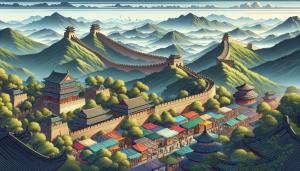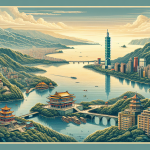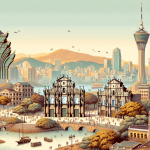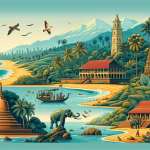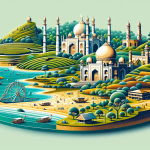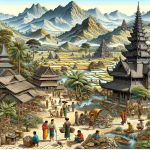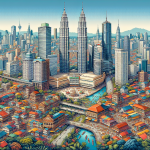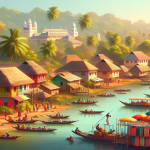Unveiling the Wonders of China: A Comprehensive Travel Guide
China, the world’s most populous country and a land teeming with ancient history, modern marvels, and rich cultural heritage, beckons travelers from every corner of the globe. From the imposing Great Wall to the bustling streets of Beijing, the serene beauty of the Yangtze River to the vibrant markets of Shanghai, China offers an array of experiences that are as diverse as its landscape. Whether you’re an adventurer, a history enthusiast, or a culinary explorer, China promises to captivate your senses and leave an indelible mark on your travel memories. In this comprehensive travel guide, we delve into the myriad wonders that China has to offer, providing you with essential information, tips, and inspiration to plan your unforgettable journey to this fascinating country. Join us as we explore the best of China’s iconic landmarks, cultural treasures, natural wonders, and vibrant cities, ensuring that your trip is nothing short of extraordinary.
Exploring China’s Iconic Landmarks
The Great Wall of China
No trip to China would be complete without visiting the Great Wall, one of the most recognizable symbols of the country. Stretching over 13,000 miles, this ancient fortification is a testament to China’s historical prowess and architectural ingenuity. The most popular sections to visit are Badaling and Mutianyu, both offering breathtaking views and relatively easy access from Beijing. For a more adventurous experience, consider exploring the less crowded Jinshanling or Simatai sections.
The Forbidden City
Located in the heart of Beijing, the Forbidden City is a sprawling palace complex that served as the imperial residence for 24 emperors during the Ming and Qing dynasties. With its intricate architecture, stunning artwork, and vast courtyards, the Forbidden City offers a glimpse into China’s imperial past. Visitors can wander through its numerous halls and pavilions, marveling at the grandeur and historical significance of this UNESCO World Heritage site.
The Terracotta Army
In the ancient city of Xi’an, the Terracotta Army stands as one of the most extraordinary archaeological discoveries of the 20th century. Discovered in 1974, this vast collection of life-sized terracotta soldiers, horses, and chariots was buried with China’s first emperor, Qin Shi Huang, to protect him in the afterlife. The site is now a museum, where visitors can witness the incredible craftsmanship and historical importance of these figures, each uniquely detailed and positioned in battle formation.
Immersing in China’s Rich Culture
Traditional Festivals
China’s rich cultural heritage is vividly showcased through its traditional festivals. The Chinese New Year, also known as the Spring Festival, is the most important and widely celebrated event in the Chinese calendar. It features dragon dances, lantern displays, and elaborate feasts. Another significant festival is the Mid-Autumn Festival, celebrated with mooncakes and family gatherings under the full moon. The Dragon Boat Festival, held in honor of the ancient poet Qu Yuan, includes exciting dragon boat races and the consumption of zongzi (sticky rice dumplings).
Tea Culture
China’s tea culture is an integral part of its history and daily life. The country is renowned for its diverse tea varieties, including green tea, black tea, oolong tea, and pu-erh tea. Visitors can experience traditional tea ceremonies in cities like Hangzhou, home to the famous Longjing (Dragon Well) tea, or explore the tea plantations in Fujian province. Tea houses, such as those in Chengdu, offer a relaxing environment to savor the rich flavors and aromas of Chinese tea while learning about its cultural significance.
Calligraphy and Painting
Chinese calligraphy and painting are revered art forms that have been practiced for centuries. Calligraphy, the art of beautiful writing, is often seen as a reflection of the artist’s personality and emotions. Traditional Chinese painting, characterized by its delicate brushwork and harmonious compositions, often depicts landscapes, flowers, and birds. Art enthusiasts can visit museums and galleries in cities like Beijing and Shanghai to admire these masterpieces, or even take part in workshops to learn the basics of these ancient arts.
Discovering China’s Natural Wonders
The Yangtze River
As the longest river in Asia and the third-longest in the world, the Yangtze River is a lifeline for millions of people in China. A cruise along the Yangtze offers an unparalleled opportunity to witness the country’s stunning natural beauty, including the magnificent Three Gorges. The river also passes through several major cities, such as Chongqing and Wuhan, providing a unique perspective on China’s diverse landscapes and cultures.
Zhangjiajie National Forest Park
Famed for its towering sandstone pillars and lush greenery, Zhangjiajie National Forest Park in Hunan province served as the inspiration for the floating mountains in the movie “Avatar.” Visitors can explore this otherworldly landscape via a network of trails and glass walkways, or take a thrilling ride on the world’s longest and highest glass bridge. The park’s scenic beauty and unique geological formations make it a must-visit destination for nature lovers and adventure seekers alike.
Guilin and the Li River
The picturesque city of Guilin, located in Guangxi province, is renowned for its karst landscape and scenic beauty. A cruise along the Li River offers breathtaking views of limestone peaks, crystal-clear waters, and traditional fishing villages. The iconic Elephant Trunk Hill and Reed Flute Cave are among the many natural attractions that draw visitors to this enchanting region. Guilin’s serene and idyllic scenery has inspired countless poets and artists throughout Chinese history.
Experiencing China’s Modern Marvels
Shanghai
As China’s largest city and a global financial hub, Shanghai is a dazzling metropolis that seamlessly blends the old and the new. The futuristic skyline of Pudong, with its iconic Oriental Pearl Tower and Shanghai Tower, stands in stark contrast to the historic Bund area, which features colonial-era architecture and scenic waterfront views. Visitors can explore the bustling markets of Nanjing Road, enjoy panoramic views from the observation decks of skyscrapers, and immerse themselves in the vibrant nightlife of this cosmopolitan city.
Hong Kong
Although a Special Administrative Region of China, Hong Kong offers a unique blend of Chinese and Western influences. The city’s skyline, dominated by towering skyscrapers, is best appreciated from Victoria Peak or during a Star Ferry ride across Victoria Harbor. Hong Kong is also a shopper’s paradise, with bustling markets, luxury malls, and street food stalls offering a diverse array of culinary delights. The city’s rich cultural heritage is showcased in attractions like the Man Mo Temple and the Hong Kong Museum of History.
Beijing
As the capital of China, Beijing is a city steeped in history and brimming with cultural treasures. In addition to the Forbidden City, visitors can explore the Temple of Heaven, a magnificent complex of religious buildings set in a vast park. The Summer Palace, with its beautiful gardens and lakes, offers a tranquil retreat from the bustling city. Beijing is also home to the vibrant 798 Art District, a hub for contemporary art and creative expression, and the bustling Wangfujing Street, known for its shopping and street food.
Savoring China’s Culinary Delights
Regional Cuisine
China’s culinary landscape is incredibly diverse, with each region offering its own unique flavors and specialties. Sichuan cuisine, known for its bold and spicy flavors, features dishes like mapo tofu and kung pao chicken. Cantonese cuisine, popularized by dim sum, emphasizes fresh ingredients and delicate flavors. Shandong cuisine, one of the oldest culinary traditions in China, is known for its seafood and hearty dishes. Jiangsu cuisine, with its focus on sweet and savory flavors, offers delicacies like sweet and sour mandarin fish.
Street Food
China’s street food scene is a culinary adventure in itself, with bustling night markets and food stalls offering a tantalizing array of snacks and delicacies. In Beijing, visitors can sample jianbing (savory crepes) and chuan’r (grilled skewers). In Xi’an, the Muslim Quarter is famous for its roujiamo (Chinese hamburgers) and biang biang noodles. Chengdu, the capital of Sichuan province, is renowned for its spicy hotpot and dan dan noodles. Exploring China’s street food is an essential part of any culinary journey in the country.
Tea and Desserts
In addition to its savory dishes, China boasts a variety of delightful desserts and sweet treats. Tangyuan (glutinous rice balls) and nian gao (sticky rice cake) are popular during festivals. Egg tarts, a legacy of Portuguese influence in Macau, are a beloved pastry in southern China. Mango pomelo sago, a refreshing dessert made with mango, pomelo, and tapioca pearls, is a favorite in Hong Kong. Pairing these sweets with a cup of fragrant jasmine tea or oolong tea completes the culinary experience.
Practical Tips for Traveling in China
Visa and Entry Requirements
Most travelers to China will need a visa, which can be obtained from Chinese embassies and consulates. It’s important to apply well in advance of your trip and ensure that your passport is valid for at least six months beyond your planned stay. Some regions, such as Hong Kong and Macau, have different entry requirements, so be sure to check the specific regulations for each destination.
Transportation
China’s extensive transportation network makes it relatively easy to travel between cities and regions. High-speed trains connect major cities, offering a convenient and efficient mode of travel. Domestic flights are also widely available, with numerous airlines operating routes across the country. In cities, public transportation options include buses, subways, and taxis. For a more immersive experience, consider renting a bicycle or taking a leisurely stroll through the city’s streets and neighborhoods.
Language and Communication
While Mandarin Chinese is the official language, many regions have their own dialects and languages. English is not widely spoken outside of major cities and tourist areas, so it’s helpful to learn some basic Mandarin phrases or carry a translation app. Having the name and address of your destination written in Chinese characters can also be useful when asking for directions or using transportation services.
Currency and Payments
The official currency of China is the Renminbi (RMB), also known as the yuan. Credit cards are widely accepted in hotels, restaurants, and larger shops, but cash is still commonly used, especially in smaller establishments and markets. ATMs are readily available in cities, but it’s a good idea to have some cash on hand for smaller purchases and tipping.
Conclusion
China is a land of contrasts, where ancient traditions coexist with modern innovations, and natural beauty complements bustling urban centers. Whether you’re exploring iconic landmarks, immersing yourself in rich cultural experiences, discovering breathtaking natural wonders, or savoring diverse culinary delights, China offers a wealth of opportunities for adventure and discovery. By planning your trip carefully and embracing the country’s unique charm, you can create memories that will last a lifetime. So pack your bags, brush up on your Mandarin, and get ready to embark on an unforgettable journey through the wonders of China.
For more detailed information on planning your trip to China, visit China Highlights.
